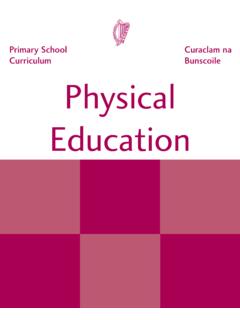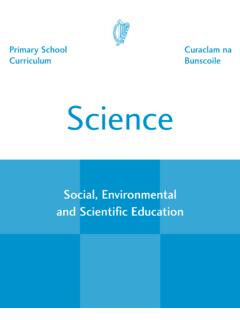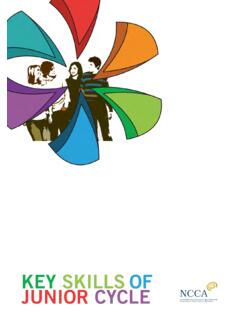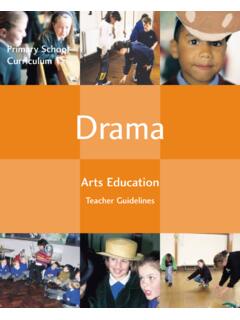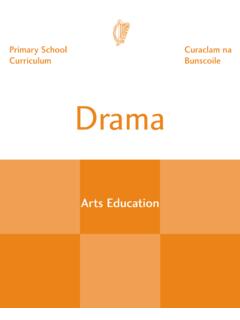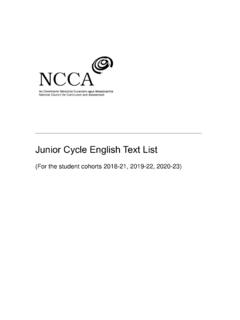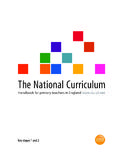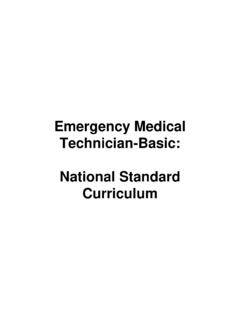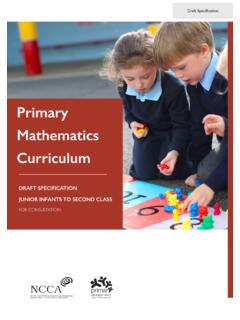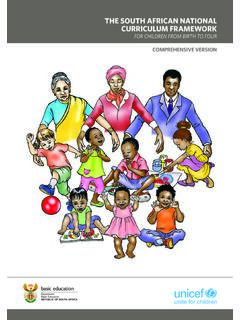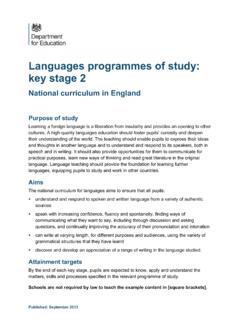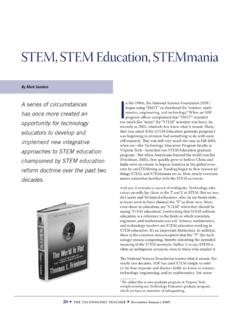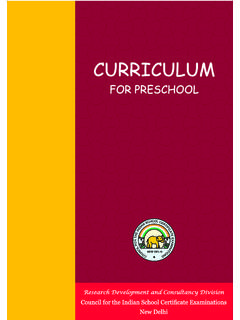Transcription of Primary School Curriculum
1 Primary School CurriculumIntroductionCuraclam naBunscoileR amhr DUBLINPUBLISHED BY THE STATIONERY OFFICETo be purchased directly from theGOVERNMENT PUBLICATIONS SALE OFFICESUN ALLIANCE HOUSEMOLESWORTH STREETDUBLIN 2or by mail order fromGOVERNMENT PUBLICATIONSPOSTAL TRADE SECTION4-5 HARCOURT ROADDUBLIN 2(Tel: 01-6476834-5; Fax: 01-4752760)or through any booksellerDesign Consultancy:Bradley McGurk PartnershipDesigned by:The Identity BusinessPhotography:Christy McNamaraTypesetting:Spectrum Print ManagementPrinted by:Mozzon Giuntina - Florence andOfficine Grafiche De Agostini - Novara 1999 Government of IrelandPrimary SchoolCurriculumIntroductionContentsMini ster s forewordChairperson s forewordIntroduction1 Aims, principles.
2 And features5 Children and learning13 Key issues in Primary education25 Chapter 2 Chapter 3 Chapter 1 Primary School Curriculum IntroductionSpecific aims and general objectives 33 Curriculum areas39 Curriculum implementation in the school61 Conclusion73 Appendix77 Membership of the Primary Co-ordinating CommitteeMembership of National Council for Curriculum and AssessmentAcknowledgementsChapter 4 Chapter 6 Chapter 5 The introduction into schools of the Primary School Curriculum (1999) is asignificant landmark in the history of Primary education in Ireland. Itrepresents the culmination of many years of development and planningthat involved all the partners and interests in Primary preparation of the Primary School Curriculum was chiefly theresponsibility of the National Council for Curriculum and Assessment(NCCA), whose function it is to advise the Minister for Education andScience on matters of Curriculum review and assessment.
3 The NCCA wasassisted in its work by committees, representing all the principal partnersand interests in Primary education, who worked on six Curriculum areas:Language; Mathematics; Social, environmental and scientific education(SESE); Arts education; Physical education; and Social, personal andhealth education (SPHE). The development and implementation of thecurriculum in religious education in Primary schools remains theresponsibility of the relevant church Primary School Curriculum constitutes a detailed interpretation of therecommendations of the Review Body on the Primary Curriculum (1990).
4 It encompasses the philosophical thrust of Curaclam na Bunscoile (1971)and the Education Act, Curriculum incorporates current educational thinking and the mosteffective pedagogical practices. It represents a process of revision that isboth evolutionary and developmental. It is designed to cater for theneeds of children in the modern introduction of the Primary School Curriculum is an excitingopportunity for change and renewal in Primary schools. I would like totake this opportunity to thank all of those who were involved in itsdevelopment. I know that I can depend on their continued co-operationand assistance as the Curriculum is implemented in l Martin TDMinister for Education and ScienceMinister s forewordviChairperson s forewordviiPrimary School Curriculum IntroductionEducation is an important factor both in the day-to-day development ofthe child and in contributing to the personal, social, cultural andeconomic fulfilment of the future adult.
5 The introduction of a revisedprimary Curriculum is, therefore, a significant educational revision of the Curriculum , guided by the recommendations of theReport of the Review Body on the Primary Curriculum (1990),incorporates the principles of Curaclam na Bunscoile(1971) and developsthem. The Primary Curriculum is seen as having a special relationshipwith second-level education and this revision has taken place in thecontext of a number of developments which have occurred in second-level education in recent revised Curriculum also incorporates new content and embraces newapproaches and methodologies.
6 A key concern of the Curriculum is theimportance of literacy and numeracy to personal fulfilment. Thecurriculum also responds to changing needs, particularly in the areas ofscience and technology, social, personal and health education, andcitizenship, and in taking account of the pilot initiative in wish to record my deep appreciation to the many people whocontributed to the process of revision: the members of the Council and,in particular, the late Dr. Tom Murphy who was chairperson until 1996,the members of the Curriculum committees and the education officerswho developed and designed the curricula for the different subjects, theChairperson and members of the Co-ordinating Committee, Ms LucyFallon-Byrne who had responsibility for the co-ordination andproduction of the Curriculum and Albert Ceallaigh, Chief Executive,NCCA under whose leadership the review and development of thecurriculum took Caroline HusseyChairpersonIntroductionThe introduction of the Primary School Curriculum (1999)
7 Represents a majordeparture in the history of Primary education in Ireland. It is theculmination of many years of development and planning that involved all thepartners and interests in Primary last major revision of the Curriculum for Primary schools was Curaclamna Bunscoile(1971). Since then there has been a combination of educational,economic, social and cultural developments in Irish society: these develop-ments have been taken into account in this process of revising the Curriculum began with the work of the ReviewBody on the Primary Curriculum , which published its report in May report constituted a detailed appraisal of the 1971 Curriculum andprovided the basis for the redesign and restructuring that is presented inthis Curriculum .
8 The development of a revised Primary Curriculum became the responsibilityof the National Council for Curriculum and Assessment, whose function itis to advise the Minister for Education and Science on matters of curriculumand assessment. The NCCA established committees representing all theprincipal partners and interests in Primary education to draw up subjectstatements and teacher guidelines in each of six Curriculum areas: Language;Mathematics; Social environmental and scientific education (SESE); Artseducation; Physical education; and Social, personal and health education(SPHE). The development and implementation of the Curriculum inreligious education in Primary schools remains the responsibility of thedifferent church Primary School Curriculumconstitutes a detailed interpretation of therecommendations of the Review Body on the Primary Curriculum (1990).
9 Itencompasses the philosophical thrust of Curaclam na Bunscoileand reflectsthe thinking and aspirations of the National Convention on Education(1994), the White Paper on Education, Charting our Education Future(1995)and the Education Act (1998). Through the work of the NCCA committees,the Curriculum incorporates current educational thinking and the mostinnovative and effective pedagogical practice. It represents a process ofIntroductionIntroduction2 Introduction3 Primary School Curriculum Introductionrevision that is both evolutionary and developmental. The Curriculum isdesigned to cater for the needs of children in the modern world, and itsintroduction is an exciting opportunity for change and renewal inprimary , principles andfeatures Chapter 1 A vision for Primary educationThe Primary School Curriculumcelebrates the uniqueness of the child, asit is expressed in each child s personality, intelligence and potential fordevelopment.
10 It is designed to nurture the child in all dimensions of his orher life spiritual, moral, cognitive, emotional, imaginative, aesthetic,social and Curriculum recognises the integrity of the child s life as a child andaims to cater for his or her needs and potential as they evolve day by meeting these needs, the Curriculum enriches the child s life and thefoundations are laid for happiness and fulfilment in later education andin adult Curriculum acknowledges that children live in and are a part of society,and that their personal development is deeply affected by their relationshipsin the home and with other people in society.
